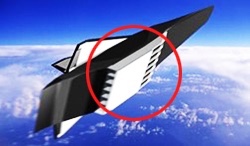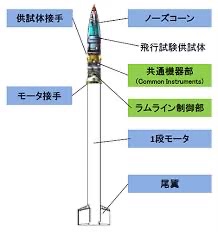

JAXA: Test the scramjet engine!
-Practical use of hypersonic scramjet engine-
-Rocket launch Kagoshima-
JAXA:
On the morning of the 24th, a sounding rocket was launched from Kimotsuki Town, Kagoshima Prefecture.
This is the first step toward “practical use of next-generation engines that greatly exceed the speed of sound.”
“S-520-RD1”:
It is the performance of hypersonic Mach 5.5.
After reaching an altitude of 170 km
Greatly exceeds the speed of sound during a fall
Reached hypersonic Mach 5.5,
The launch was successful.
This launch:
We conducted a “combustion test in flight at hypersonic speed” and observed data such as pressure.
It enables “flying at hypersonic speeds exceeding Mach 5”.
Traditional rocket engine:
The conventional rocket engine uses “oxygen in the oxygen tank when burning fuel”.
Scramjet engine:
“Since oxygen in the atmosphere is used, the tank itself is unnecessary.”
It is possible to “load a lot of cargo”.
It is expected to be used for spacecraft in the future.
Acquisition, Technology and Logistics Agency:
On the other hand, the Acquisition, Technology and Logistics Agency, which commissioned the research,
We would like to utilize the test results in future defense fields such as hypersonic guided bullets.
https://www.mbc.co.jp/news/article/2022072400058000.html
JAXA : Testez le moteur scramjet !
-Utilisation pratique du moteur scramjet hypersonique-
-Lancement de fusée Kagoshima-
JAXA :
Le matin du 24, une fusée-sonde a été lancée depuis la ville de Kimotsuki, préfecture de Kagoshima.
C’est la première étape vers “l’utilisation pratique des moteurs de nouvelle génération qui dépassent largement la vitesse du son”.
“S-520-RD1”:
C’est la performance hypersonique de Mach 5.5.
Après avoir atteint une altitude de 170 km
Dépasse largement la vitesse du son lors d’une chute
Mach 5,5 hypersonique atteint,
Le lancement a été un succès.
Ce lancement :
Nous avons effectué un “test de combustion en vol à vitesse hypersonique” et observé des données telles que la pression.
Il permet de “voler à des vitesses hypersoniques dépassant Mach 5”.
Moteur fusée traditionnel :
Le moteur de fusée conventionnel utilise “l’oxygène dans le réservoir d’oxygène lors de la combustion du carburant”.
Moteur Scramjet :
“Puisque l’oxygène dans l’atmosphère est utilisé, le réservoir lui-même n’est pas nécessaire.”
Il est possible de “charger beaucoup de fret”.
Il devrait être utilisé pour les engins spatiaux à l’avenir.
Agence Acquisition, Technologie et Logistique :
D’autre part, l’Agence Acquisition, Technologie et Logistique, commanditaire de la recherche,
Nous aimerions utiliser les résultats des tests dans les futurs domaines de la défense tels que les balles guidées hypersoniques.
JAXA: Testen Sie das Scramjet-Triebwerk!
-Praktischer Einsatz des Hyperschall-Scramjet-Triebwerks-
-Raketenstart Kagoshima-
JAXA:
Am Morgen des 24. wurde eine Höhenforschungsrakete von der Stadt Kimotsuki in der Präfektur Kagoshima aus gestartet.
Dies sei der erste Schritt zum „praktischen Einsatz von Motoren der nächsten Generation, die die Schallgeschwindigkeit bei weitem überschreiten“.
“S-520-RD1”:
Es ist die Leistung von Hyperschall Mach 5.5.
Nach Erreichen einer Höhe von 170 km
Übersteigt bei einem Sturz die Schallgeschwindigkeit bei weitem
Erreichte Hyperschall Mach 5,5,
Der Start war erfolgreich.
Dieser Start:
Wir haben einen “Verbrennungstest im Flug mit Überschallgeschwindigkeit” durchgeführt und Daten wie den Druck beobachtet.
Es ermöglicht “das Fliegen mit Hyperschallgeschwindigkeiten von mehr als Mach 5”.
Traditioneller Raketenmotor:
Das herkömmliche Raketentriebwerk verwendet “Sauerstoff im Sauerstofftank beim Verbrennen von Treibstoff”.
Scramjet-Triebwerk:
“Da Sauerstoff in der Atmosphäre verwendet wird, ist der Tank selbst unnötig.”
Es ist möglich, “viel Fracht zu laden”.
Es wird erwartet, dass es in Zukunft für Raumfahrzeuge verwendet wird.
Akquisitions-, Technologie- und Logistikagentur:
Andererseits hat die Akquisitions-, Technologie- und Logistikagentur, die die Untersuchung in Auftrag gegeben hat,
Die Testergebnisse möchten wir in zukünftigen Verteidigungsfeldern wie hyperschallgelenkten Geschossen nutzen.
Japan’s space agency tests future supersonic scramjet engine specimen
NHK WORLD-JAPAN News
Japan’s space agency has announced
that it successfully test-launched a small research rocket, which conducted tests for a future supersonic scramjet engine.
The Japan Aerospace Exploration Agency, or JAXA, is researching the engine.
The engine uses atmospheric oxygen
to burn engine fuel with the airflow through it remaining supersonic or faster.
As it does not need loaded oxygen on board, the scramjet will allow a heavier payload to be carried.
JAXA
launched an S-520-RD rocket into space at 5:00 a.m. Sunday from Uchinoura Space Center in Kagoshima Prefecture in southwestern Japan.
The rocket
reached an altitude of 168 kilometers three and half minutes after the launch.
The nose of the rocket
contains test equipment for the scramjet engine which was detached from the craft.
JAXA’s team leader,
Tani Koichiro
told reporters that they could collect all the data that they planned to get and that the launch was a big step in the development of the engine.
The test launch is a part of a project adopted by Japanese Defense Ministry’s acquisitions agency.
The officials say that they hope the project can be used in the defense field in the future.